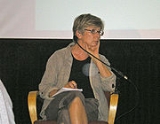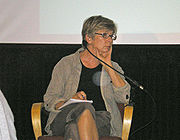
Dancing in the Streets: A History of Collective Joy
Encyclopedia

Barbara Ehrenreich
-Early life:Ehrenreich was born Barbara Alexander to Isabelle Oxley and Ben Howes Alexander in Butte, Montana, which she describes as then being "a bustling, brawling, blue collar mining town."...
.
The author coins the term "collective joy" to describe group events which involve music, synchronized movement, costumes, and a feeling of loss of self. There is no precise word in English to describe the phenomenon.
The book describes cycles of creation and suppression of collective joy events. The events generally arise spontaneously and are regarded as dangerous (see Collective hysteria
Collective hysteria
Mass hysteria—other names include collective hysteria, group hysteria, or collective obsessional behavior—is the manifestation of the same or similar hysterical symptoms by more than one person. A common manifestation of mass hysteria occurs when a group of people believe they are suffering from a...
, Riot
Riot
A riot is a form of civil disorder characterized often by what is thought of as disorganized groups lashing out in a sudden and intense rash of violence against authority, property or people. While individuals may attempt to lead or control a riot, riots are thought to be typically chaotic and...
). The powerful elements of society gradually convert the participants into spectators. This conversion drains the events of their power, and the cycle begins anew. The author describes Western Society as particularly lacking in such events and describes current and recent examples of Collective Joy events.
Current
- Brazilian CarnivalBrazilian CarnivalThe Carnival of Brazil is an annual festival held forty-six days before Easter. On certain days of Lent, Roman Catholics and some other Christians traditionally abstained from the consumption of meat and poultry, hence the term "carnival," from carnelevare, "to remove meat." Carnival celebrations...
and Mardi GrasMardi GrasThe terms "Mardi Gras" , "Mardi Gras season", and "Carnival season", in English, refer to events of the Carnival celebrations, beginning on or after Epiphany and culminating on the day before Ash Wednesday...
- Burning ManBurning ManBurning Man is a week-long annual event held in the Black Rock Desert in northern Nevada, in the United States. The event starts on the Monday before the American Labor Day holiday, and ends on the holiday itself. It takes its name from the ritual burning of a large wooden effigy on Saturday evening...
: Possibly the best modern example of collective joy, this event erases social boundaries, encourages participation as a near-religious experience, and has no basis in a historical or religious festival.
- Rock concertRock concertThe term rock concert refers to a musical performance in the style of any one of many genres inspired by "rock and roll" music. While a variety of vocal and instrumental styles can constitute a rock concert, this phenomenon is typically characterized by bands playing at least one electric guitar,...
s and ravesRaveRave, rave dance, and rave party are parties that originated mostly from acid house parties, which featured fast-paced electronic music and light shows. At these parties people dance and socialize to dance music played by disc jockeys and occasionally live performers...
: The most familiar example of collective joy to most Americans. The term especially applies to Grateful DeadGrateful DeadThe Grateful Dead was an American rock band formed in 1965 in the San Francisco Bay Area. The band was known for its unique and eclectic style, which fused elements of rock, folk, bluegrass, blues, reggae, country, improvisational jazz, psychedelia, and space rock, and for live performances of long...
concertsConcertA concert is a live performance before an audience. The performance may be by a single musician, sometimes then called a recital, or by a musical ensemble, such as an orchestra, a choir, or a musical band...
.
- Love ParadeLove ParadeThe Love Parade was a popular electronic dance music festival and parade that originated in 1989 in West Berlin, Germany. It was held in Germany annually between 1989 and 2003 in Berlin, and then from 2006 to 2010 in the Ruhr region...
: costumed dancers and electronic music festival held in many cities around the world.
Collective Joy in transition
- Sports fansFan (person)A Fan, sometimes also called aficionado or supporter, is a person with a liking and enthusiasm for something, such as a band or a sports team. Fans of a particular thing or person constitute its fanbase or fandom...
: The author contends that group movement like "the waveAudience waveThe wave or the Mexican wave is an example of metachronal rhythm achieved in a packed stadium when successive groups of spectators briefly stand and raise their arms...
" and costuming (body paint, team colors) are an attempt to wrest the spectator nature of professional sports back into the realm of collective joy by making fans active participants in the team events.
- HalloweenHalloweenHallowe'en , also known as Halloween or All Hallows' Eve, is a yearly holiday observed around the world on October 31, the night before All Saints' Day...
: In the past three decades, Halloween has transitioned from a children's holiday to an adult holiday, including street fairsStreet fairA street fair is a fair that celebrates the character of a neighborhood. As its name suggests, it is usually held on the main street of a neighborhood....
in major cities such as New York's Village Halloween ParadeNew York's Village Halloween ParadeNew York's Village Halloween Parade is an annual holiday parade and street pageant presented the night of every Halloween in New York City’s Greenwich Village...
and San Francisco's Castro District.
Other Collective Joy festivals
Collective Joy festivals can be found in many localities, though seldom known as such.- California: Bay Area: Bay To BreakersBay to BreakersThe Bay to Breakers is an annual footrace which takes place in San Francisco, California on the third Sunday of May. The name reflects the fact that the race starts at the northeast end of the downtown area a few blocks from The Embarcadero and runs west through the city to finish at the Great...
footrace: costumed runners/walkers, dozens of bands, house parties along the race route, followed by a music concert at the end of the route. - California: Bay Area: Lindy In the Park (weekly event). Originally part of the Swing RevivalSwing RevivalThe Swing Revival was a late 1990s and early 2000s period of renewed popular interest in swing and jump blues music and dance from the 1930s and 1940s as exemplified by Louis Prima, often mixed with a more contemporary rock, rockabilly or ska sound, known also as neo-swing or retro...
, this event began in 1996 and continues as a free venue for swing dancing in Golden Gate ParkGolden Gate ParkGolden Gate Park, located in San Francisco, California, is a large urban park consisting of of public grounds. Configured as a rectangle, it is similar in shape but 20% larger than Central Park in New York, to which it is often compared. It is over three miles long east to west, and about half a...
.

